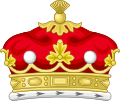Personal life
He married Jane Elizabeth Angela, daughter of Alistair Monteith Gibb, in 1972. They had one son and two daughters before getting divorced in 1990: [2]
- Alastair Gordon, Earl of Aboyne (b. 1973), who married Sophia Cunningham, daughter of Michael Cunningham, in 2004. [2]
- Lady Amy Jane Gordon (b. 1975) [2]
- Lady Lucy Yoskyl Gordon (b. Jul 1979) [2]
Lord Huntly married secondly in 1991 to Catheryn Milbourn (née Kindersley). The former wife of Robert Lennon Milbourn, she was the eldest daughter of Gay Kindersley (a grandson of Robert Kindersley, 1st Baron Kindersley) and the former Margaret Diana Wakefield (a daughter of Hugh Wakefield of Mayfair, London). The Marchioness is a Patroness of the Royal Caledonian Ball. [3] Together, they were the parents of one daughter: [2]
- Lady Rose Marie-Louise Gordon (b. 1993) [2]
The seat of Lord and Lady Huntly is Aboyne Castle in Aberdeenshire. [2]
This page is based on this
Wikipedia article Text is available under the
CC BY-SA 4.0 license; additional terms may apply.
Images, videos and audio are available under their respective licenses.

